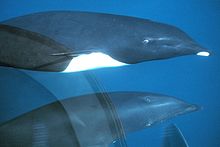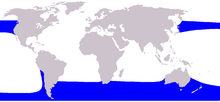Right whale dolphin
| Right whale dolphins | |
|---|---|

| |
| Northern species, Lissodelphis borealis | |
| Scientific classification | |
| Domain: | Eukaryota |
| Kingdom: | Animalia |
| Phylum: | Chordata |
| Class: | Mammalia |
| Order: | Artiodactyla |
| Infraorder: | Cetacea |
| Family: | Delphinidae |
| Subfamily: | Lissodelphininae |
| Genus: | Lissodelphis Gloger, 1841 |
| Type species | |
Delphinus peronii [1] Lacépède, 1804
| |
| Species | |
|
| |

| |
| Northern and southern right whale dolphin ranges | |
Right whale dolphins are
Physical description

Both species have slender bodies, small, pointed flippers and a small fluke. Conspicuously, neither species has a dorsal fin; nor do right whales and this may explain the dolphins' name. The northern right whale dolphin is the only dolphin in the Pacific with this property. Similarly, the Southern is the only finless dolphin in the southern hemisphere. The two species can be readily distinguished (apart from the geographical separation in their ranges) by the extent of the whiteness on the body. Both have white bellies; however, the area of white coloration on the Southern species covers much more of the body — including the flanks, flippers, beak and forehead.
Northern males are about 220 cm (87 in) long at sexual maturity. Females are 200 cm (79 in). Both sexes become mature at about 10 years. New-born right whale dolphins are about half the length of their parents. The southern species is typically larger (up to 250 cm (98 in)) and heavier (up to 100 kg (220 lb) compared with the Northern's maximum of 80–90 kg (180–200 lb)). The dolphins live for about 40 years.
Distribution
The
The southern right whale dolphin has a circumpolar distribution running from about 40° to 55°. They are sighted in the Tasman Sea in particular.
Behaviour

Both species are highly gregarious. They move in pods of several hundred individuals and sometimes congregate in groups of 3000.[2] The groups may also contain dusky dolphins and pilot whales (in the south) and Pacific white-sided dolphins (in the north). These dolphins are some of the fastest swimmers (in excess of 40 km/h). They can by turns become very boisterous and breach and tail-slap or become very quiet and almost undetectable at sea. At high speed they can leap up to 7 metres across the ocean's surface in a graceful bouncing motion.
The species will generally avoid boats, but bow-riding has been recorded on occasion.
A single and rare stranding has been recorded for the northern species. On 9 June 2018, a 5.5-foot female was found deceased on Manzanita Beach on the coast of Oregon. There has been one recorded instance of 77 southern right whale dolphins stranding on Chatham Island.
Conservation
The southern species is under pressure from Peruvian whaling operations. The northern species has never been commercially targeted. However, tens of thousands of the northern species were killed in the 1980s due to their becoming caught in oceanic drift
Attempts to keep right whale dolphins in aquaria have all ended in failure and death. In all cases but one, they have died within three weeks.
References
Notes
- OCLC 62265494.
- ISBN 9780306375736.
Other sources
- National Audubon Society Guide to Marine Mammals of the World (2006), ISBN 0-375-41141-0
- ISBN 0-12-551340-2
- ISBN 0-7513-2781-6
